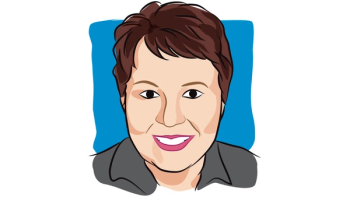
Former Google Executive Jeff Huber Wants to Detect Cancer Earlier
After working as an executive in companies like Google and eBay, Jeff Huber switched gears to work on developing a blood test to detect cancer—a mission that has a personal connection for Huber.
As a former executive of Google, eBay and other companies, Jeff Huber has spent nearly three decades using computer science and big data to create better products for consumers. As CEO of Grail, Huber’s mission — and the mission of the company — is to “detect cancer early, when it can be cured.”
Grail is developing a blood test for asymptomatic individuals and has attracted some high-profile investors, including Bill Gates and Bezos Expeditions, which is owned by Amazon founder Jeff Bezos.
What is your personal story with cancer?
What was treatment like for her? What was it like for you as her caregiver?
CURE interviewed Huber to gain further insight into the mission of Grail and learn about his personal story with cancer.The most direct and personal involvement I've had with cancer was with my wife, Laura, who was diagnosed in April 2014 with colon cancer. It was a somewhat of a shock. She had hardly any symptoms leading up to it — not much of a family history of cancer — and went from being healthy to a stage 4 diagnosis in a very short period of time. The first symptoms of any kind were vague and started, roughly, in January of that year. That led to a multi-month odyssey that culminated in a diagnosis.The first sensation for both her and me was just shock. Shock at going from being healthy with no family history and no expectation of it, to the crushing stage 4 diagnosis. With a stage 4 diagnosis, there are survivor stories that we love hearing, but looking at the statistics of it, it was a grim diagnosis.
After that, Laura was incredibly positive and high-energy and she just threw everything she had — and me, as well — into the question of what would it take to be a survivor and come out the other side of this. After the challenging initial diagnosis, she jumped into an aggressive chemotherapy campaign and the initial results were quite positive. Her initial carcinoembryonic antigen (CEA) reading when she was diagnosed was 540, which was 100 times higher than normal, but after the initial, rough chemotherapy campaign, it got all the way down to 6. There was good reason for optimism that maybe she was the lucky case of somebody who's going to respond and come out the other side.
What went into your decision to join Grail?
Unfortunately, the biomarker (CEA) started bouncing back up and she went through the full standard-of-care evolution over the next 18 months. (Editor’s note: Laura passed away in November 2015)I had started at Google X focusing on life sciences before Laura was diagnosed, so the situation was completely coincidental. The driver behind my career shift was that just as I thought about the next decade of my career and the place for the potential for biggest impact, it felt like the nature of the underlying science behind biology was changing — you have new technologies coming along like genome sequencing, where you're able to effectively digitize biology and accelerate science. That intersection of biology and computer science, I thought, would be an important area and important opportunity.
What is the mission of Grail?
Clearly, cancer is one of the most complex biological processes. I knew it would be important to answer the question of how to best bring big data to gain insight on cancer. Grail's mission is very simple, it's eight words: Detect cancer early, when it can be cured.
What does the mission mean to you?
Today, when cancer is discovered early, outcomes are 80 to 90 percent positive. People can get the intervention and their life can be saved. In many cases today, for solid tumor cancers, that means surgery — the tumor is cut out before it spreads. Cancer caught later, at stage 3 or stage 4, when it has spread and become more complex — unfortunately, it's the inverse, about 80 to 90 percent negative.
What is your team developing at Grail?
What is your key message — both for patients and survivors, but also for health care professionals?
If we can, on a systematic basis, give people a test or tool for discovering cancer early and people can get an intervention or treatment earlier, that's the clearest path to saving millions of lives.Ultimately, Grail will develop a blood test that will be integrated in the standard system of medical care. If you're a well patient, not diagnosed with cancer, and go into your annual physical exam — today, you already get a blood test for glucose, cholesterol, and basic blood chemistry — you can have an option of one more thing, the Grail test, which will give you the opportunity to save your life if cancer is discovered. It's broadly applicable and should be a widely available test for everyone.I'd like to underscore the fact that there are diagnostic tests out there today — things like colonoscopies for colon cancer. Do whatever you can and be diligent to give yourself the best chance of catching cancer earlier and having the best outcomes.
As an industry, we have to push on all fronts — medical care, the government on policy — to help speed the development of more and more effective treatments. There has been great progress with immunotherapies, but there is much more work that needs to be done.
With the work that we're doing, hopefully we'll get more people to catch cancer early, get an intervention and, ultimately, be cured. The purpose behind everything we're doing is to save lives.





